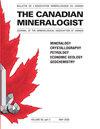Kainotropite, Cu4Fe3+O2(V2O7)(VO4), a new mineral with a complex vanadate anion from fumarolic exhalations of the Tolbachik volcano, Kamchatka, Russia
IF 1.5
4区 地球科学
Q3 MINERALOGY
引用次数: 4
Abstract
The new mineral kainotropite Cu4Fe3+O2(V2O7)(VO4) was found in sublimates of fumaroles related to the Tolbachik volcano, Kamchatka, Russia. The holotype specimen originates from the Yadovitaya fumarole at the Second scoria cone of the Northern Breakthrough of the Great Tolbachik Fissure Eruption; associated minerals are hematite, langbeinite, calciolangbeinite, tenorite, piypite, lyonsite, rutile, pseudobrookite, sanidine, and lammerite. In paleo-fumarolic deposits of Mountain 1004 kainotropite is associated with diopside and hematite. It forms prismatic crystals up to 0.2 × 0.2 × 0.5 mm3, isolated or combined in clusters up to 0.7 mm across. Kainotropite is iron-black to reddish-black, with semi-metallic luster. Dcalc is 4.10 g/cm3. In reflected light, kainotropite is grey, weakly anisotropic. The reflectance values [Rmax–Rmin,% (λ, nm)] are: 18.3–17.3 (470), 17.3–16.3 (546), 16.9–15.7 (589), 16.3–15.1 (650). The chemical composition of the holotype sample (wt.%, electron microprobe) is: CuO 46.69, Al2O3 1.40, Fe2O3 10.04, TiO2 0.32, V2O5 37.58, As2O5 2.55, MoO3 0.76, total 99.34. The empirical formula, based on 13 O apfu, is: Cu3.96Fe3+0.85Al0.19Ti0.03(V2.78As0.15Mo0.04)Σ2.97O13. Kainotropite is orthorhombic, Pnma, a = 14.139(2), b = 6.7102(7), c = 11.4177(15) Å, V = 1083.3(2) Å3, and Z = 4. The strongest reflections of the powder XRD pattern [d,Å(I)(hkl)] are: 8.89(100)(101), 5.728(33)(002), 3.698(35)(212), 3.357(52)(020,203), 3.034(77)(220), 2.968(60)(303), and 2.655(27)(321,204). The crystal structure was solved from single-crystal XRD data, R = 0.085. Kainotropite represents a novel structure type. Cu2+ polyhedra (distorted tetragonal pyramids and strongly distorted octahedra) and Fe3+ octahedra are connected via common edges to form zigzag ribbons. Adjacent ribbons are connected by both V2O7 and VO4 groups (isolated from each other) to form a heteropolyhedral pseudo-framework. The name kainotropite is derived from the Greek word καινóτρoπoς, unusual, in allusion to its uncommon (for natural vanadates) anionic composition: it is the first mineral containing both pyrovanadate (V2O7)4– and orthovanadate (VO4)3– anions.kainotroite, Cu4Fe3+O2(V2O7)(VO4),一种含钒酸盐阴离子的新矿物,产自俄罗斯堪察加托尔巴切克火山喷发物
在与俄罗斯堪察加半岛托尔巴奇克火山有关的富马孔升华物中发现了新矿物kainotropite Cu4Fe3+O2(V2O7)(VO4)。正模标本来源于托尔巴奇克大爆发北部突破第二个焦锥的Yadovitaya富马孔;伴生矿物有赤铁矿、郎贝母矿、钙青贝母岩、铁铁矿、磷铁矿、绿辉石、金红石、假板钛矿、闪长岩和lammerite。在1004山的古富马酸矿床中,kainotropite与透辉石和赤铁矿有关。它形成高达0.2×0.2×0.5 mm3的棱柱状晶体,分离或组合成直径达0.7 mm的团簇。Kainotropite为铁黑色至红黑色,具有半金属光泽。Dcalc为4.10 g/cm3。在反射光中,钙长石呈灰色,呈弱各向异性。反射率值[Rmax–Rmin,%(λ,nm)]分别为:18.3–17.3(470)、17.3–16.3(546)、16.9–15.7(589)、16.3–15.1(650)。正模样品的化学成分(wt.%,电子探针)为:CuO 46.69,Al2O3 1.40,Fe2O3 1004,TiO2 0.32,V2O5 37.58,As2O5 2.55,MoO3 0.76,总计99.34。基于13O apfu的经验公式为:Cu3.96Fe3+0.85Al0.19Ti0.03(V2.78As0.15Mo0.04)∑2.97O13。Kainotropite是斜方晶系,Pnma,a=14.139(2),b=6.7102(7),c=11.4177(15)Å,V=1083.3(2)Å3,Z=4。粉末XRD图谱的最强反射[d,Å(I)(hkl)]为:8.89(100)(101)、5.728(33)(002)、3.698(35)(212)、3.357(52)(020203)、3.034(77)(220)、2.968(60)(303)和2.655(27)(321204)。晶体结构由单晶XRD数据求解,R=0.085。Kainotropite是一种新颖的结构类型。Cu2+多面体(扭曲的四方棱锥和强烈扭曲的八面体)和Fe3+八面体通过公共边缘连接,形成Z字形带。相邻的带状物由V2O7和VO4基团(彼此隔离)连接,形成杂多面体伪骨架。kainotropite这个名字来源于希腊语καιςτρoπoς,不寻常,暗指其不常见的(天然钒酸盐)阴离子组成:它是第一种同时含有焦钒酸盐(V2O7)4–和正钒酸酯(VO4)3–阴离子的矿物。
本文章由计算机程序翻译,如有差异,请以英文原文为准。
求助全文
约1分钟内获得全文
求助全文
来源期刊

Canadian Mineralogist
地学-矿物学
CiteScore
2.20
自引率
22.20%
发文量
45
审稿时长
4-8 weeks
期刊介绍:
Since 1962, The Canadian Mineralogist has published papers dealing with all aspects of mineralogy, crystallography, petrology, economic geology, geochemistry, and applied mineralogy.
 求助内容:
求助内容: 应助结果提醒方式:
应助结果提醒方式:


